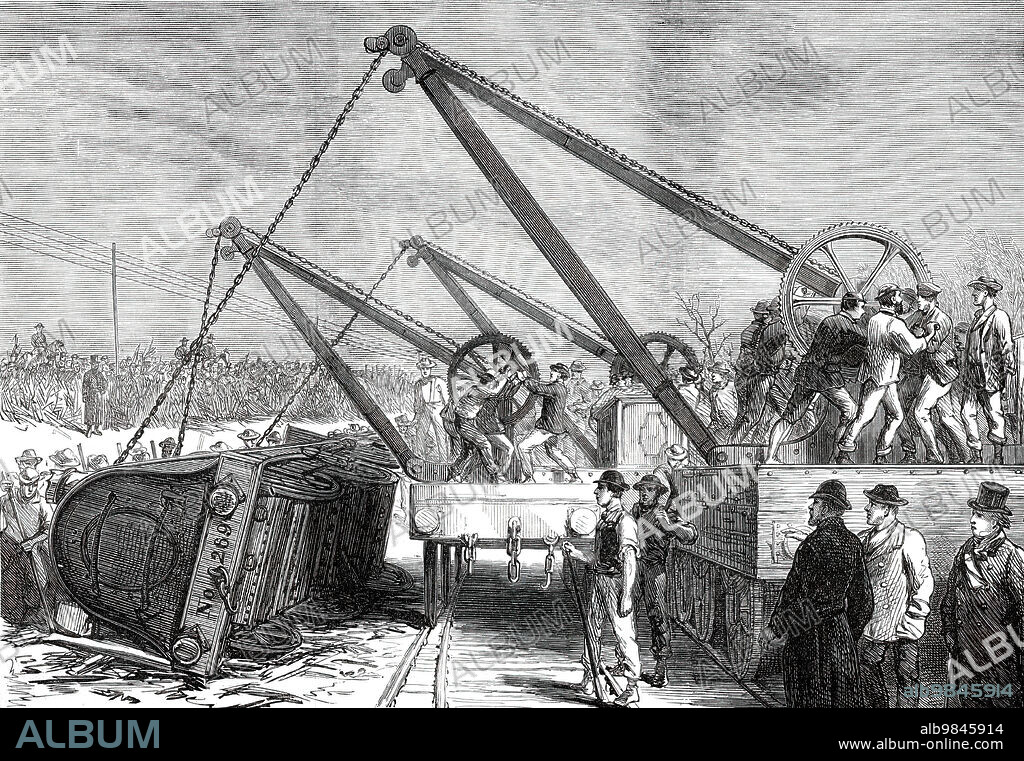alb9845914
The Railway Accident at Abbotts Ripton, Huntingdon: raising an engine from the wrecked train, 1876. Creator: Unknown.

|
Add to another lightbox |
|
Add to another lightbox |



Title:
The Railway Accident at Abbotts Ripton, Huntingdon: raising an engine from the wrecked train, 1876. Creator: Unknown.
Caption:
The Railway Accident at Abbotts Ripton, Huntingdon: raising an engine from the wrecked train, 1876. On 21 January 1876, the Edinburgh-London Special Scotch Express was involved in a collision, during a blizzard, with a coal train on the Great Northern Railway main line. A second collision occurred minutes later when an express to Leeds crashed into the wreckage obstructing the northbound line. Thirteen passengers died, and 53 passengers and 6 traincrew members were injured. Factors included signal failure, bad weather and poor visibility. Snow and ice on the wires by which the semaphore arm should be moved had meant that when signalmen had changed levers from the normal 'all clear', the signals did not fully move to 'danger'. The accident (and subsequent inquiry) led to fundamental changes in British railway signalling practice. From "Illustrated London News", 1876. From "Illustrated London News", 1876.
Credit:
Album / The Print Collector/Heritage Images
Releases:
Model: No - Property: No
Rights questions?
Rights questions?
Image size:
4960 x 3428 px | 48.6 MB
Print size:
42.0 x 29.0 cm | 16.5 x 11.4 in (300 dpi)
Keywords:
19TH CENTURY • 19TH • ABBOTTS RIPTON • ACCIDENT • ART • ARTS • BLACK & WHITE • BLACK AND WHITE • BRITAIN • BRITISH • CAMBRIDGESHIRE • CATASTROPHE • CENTURY • CHANGING ROOM • CIVIL ENGINEER • CIVIL ENGINEERING • CIVIL ENGINEERS • CLOTHES • CLOTHING & DRESS • CLOTHING • COAL • COG • COGS • COLLISION • COLOR • COLOUR • COMMUNICATION • COMMUNICATIONS • CONCEPT • CRANE • CRÂNES • CRASH • DEATH • DEATHS • DENTITION • DENTURE • DESIGN • DISASTER • DRESS • DRESSED • ENGINE • ENGINEERING • ENGLAND • ENGRAVED • ENGRAVING • FAILED • FAILURE • FASHION & CLOTHING • FLYING SCOTSMAN • FREIGHT TRAIN • FUEL • GARMENT • GNR • GOODS TRAIN • GREAT NORTHERN RAILWAY • GUY • HABIT • ILLUSTRATED LONDON NEWS • ILN • INCIDENT • JOB • LIFTING GEAR • LIFTING • LOCATION • MALE • MAN • MEN • MENSWEAR • NEWSPAPER • NEWSPAPERS • NINETEENTH CENTURY • OCCUPATION • PEOPLE • PRESS • PRINT COLLECTOR, THE • PRINT • PROFESSION • PRONG • PUBLIC TRANSPORT • PUBLIC TRANSPORTATION • RAILWAY • RAILWAYS • SEASON • SET OF TEETH • SIGNALLING • SIGNALS • SMASH-UP • SNOW • STEAM LOCOMOTIVE • TAILOR • TECHNOLOGY • TEETH • TOOTH • TRAIN ACCIDENT • TRAIN CRASH • TRAIN • TRANSPORT • TRANSPORTATION • TRANSPORTE PUBLICO • WAGGON • WAGGONS • WAGON • WAGONS • WEATHER • WHEEL • WHEELED • WHEELS • WHITE AND BLACK • WINTER • WINTRY • WRECKAGE • XIX CENTURY
 Pinterest
Pinterest Twitter
Twitter Facebook
Facebook Copy link
Copy link Email
Email

